MARIANI’S
Virtual
Gourmet
March 25, 2018
NEWSLETTER
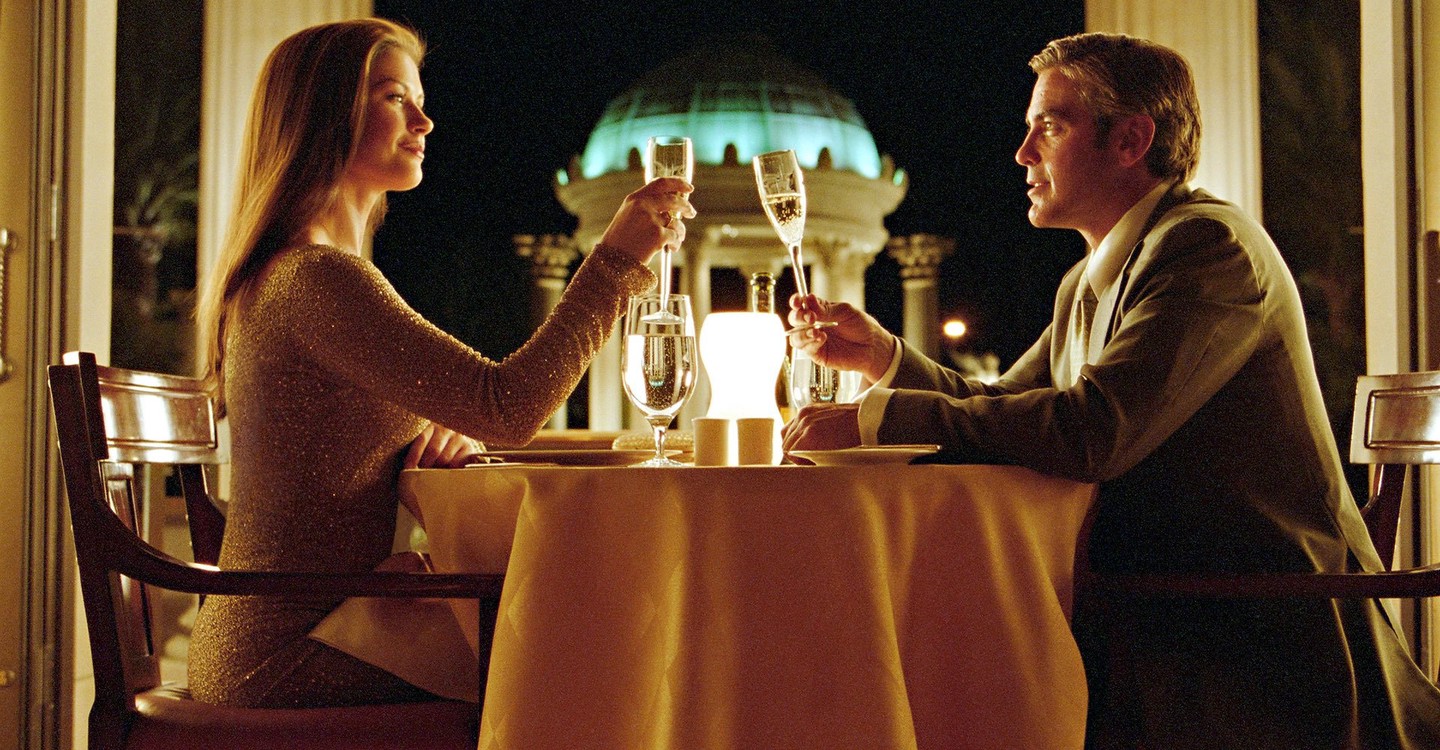
❖❖❖
IN THIS ISSUE
HIGHLANDS, NC
By John Mariani
NEW YORK CORNER
SUSHI SEKI TIMES SQUARE
By John Mariani
NOTES FROM THE WINE CELLAR
WINES FOR EASTER DINNER
By John Mariani
❖❖❖
HIGHLANDS, NC
By John Mariani
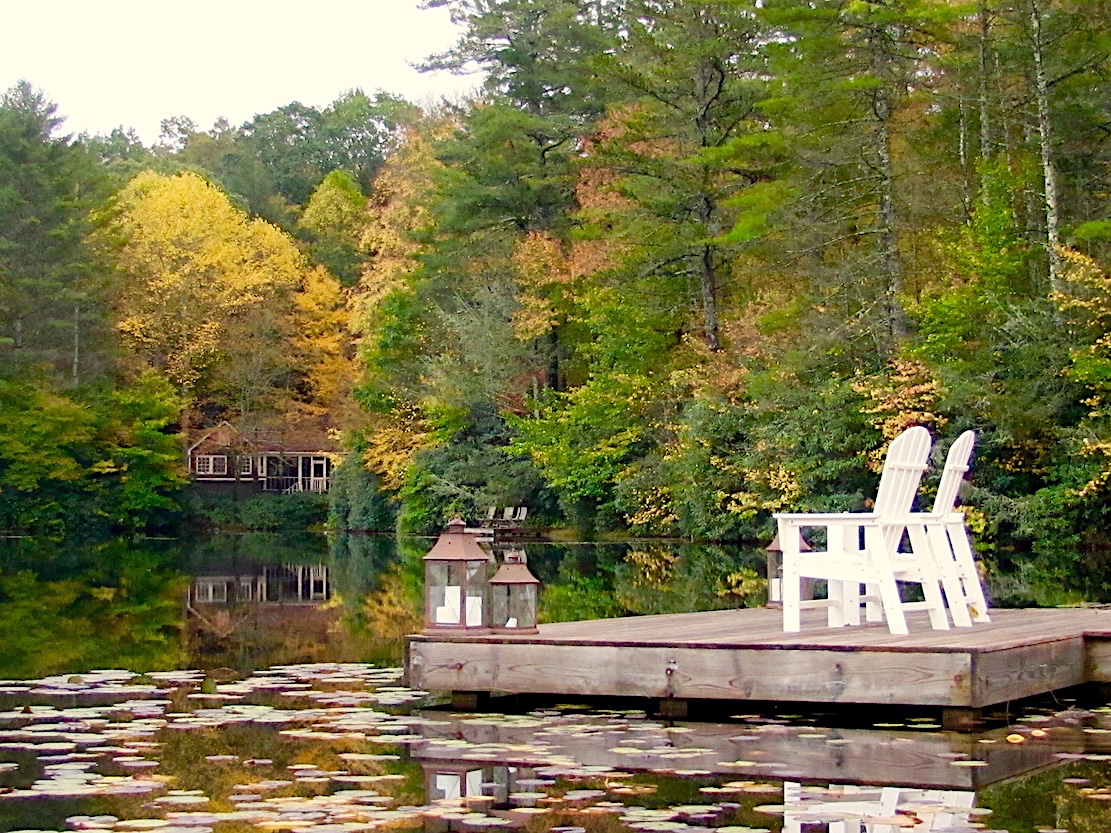
Apple Lake, Highlands NC
You know you’re in a small,
sleepy North
Carolina town when the headline on lead story
on the front page of the local
paper, The Highlander, reads—in
72-point type—“Town Tackles Pothole Fix.”
Still, while the town of Highlands has only
3,200 year-round residents—up from 924 in the 2010
U.S. Census—come summer the
population swells to 18,000, despite being an
almost three-hour drive from Atlanta and
two from Greenville. In winter the town tries
mightily to attract visitors with
events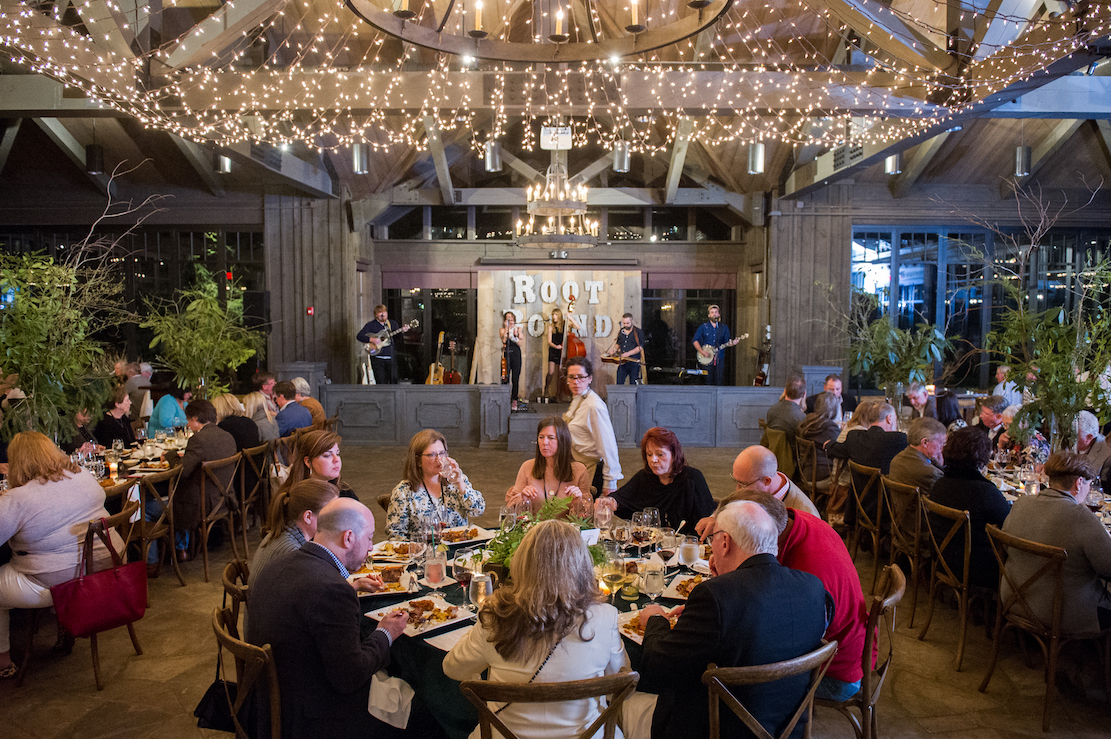 like Root Bound (left), a
celebration of Appalachian food, craft and music
culture, which I attended last month in venues
spread over 6.2 square miles.
Along with The
Bascom: Center for Visual Arts, the cross streets
of town are lined with galleries, boutiques,
restaurants and a first-rate wineshop within the
Mountain Fresh Grocery.
like Root Bound (left), a
celebration of Appalachian food, craft and music
culture, which I attended last month in venues
spread over 6.2 square miles.
Along with The
Bascom: Center for Visual Arts, the cross streets
of town are lined with galleries, boutiques,
restaurants and a first-rate wineshop within the
Mountain Fresh Grocery.
One of the town’s
principal draws is that it’s
not so hot, by which I mean climatically. But it's
very cool. For centuries wealthy North
Carolinians escaped the brutal summer heat and
humidity of the rest of state by
ascending to 4,118 feet in the Blue Ridge
Mountains, where summer temperatures
in Highlands average 76 degrees. And those deep,
piney mountains are very
beautiful, punctuated with hollows and waterfalls,
rivers and lakes that filled
in for upstate New York in the 1992 movie The
Last of the Mohicans, which was filmed
nearby Bridal Veil Falls (below).
The Root Bound
festival, spread over a weekend,
had workshops in everything from biscuit making to
whiskey tasting, salt tasting to
songwriting, and at each night’s dinners
top-flight bluegrass bands performed,
including the Forlorn Strangers, Nitrograss, the
SteelDrivers and the Dixie
Bluegrass Boys.
Sadly, the updated Appalachian
food served at
the luncheons and dinners by young restaurant
chefs failed to please many of
those Southerners who attended. The chefs insisted
on cooking up grub like
souse (headcheese), rabbit liver mush and grits
soup that North Carolinians
gave up eating as soon as they had money enough to
eat better things. Even one
of the attending great Southern chefs, Louis
Osteen, told me he never grew up eating that
kind of food.
One of the best events I
attended was a
fascinating conversation between Kentucky-born
food historian Ronni Lundy,
formerly of the Louisville Courier-Journal,
and best-selling author Sharyn McCrumb (below), whose
books The Ballad of Tom Dooley and The
Unquiet Grave brought to life the reality
behind the folklore.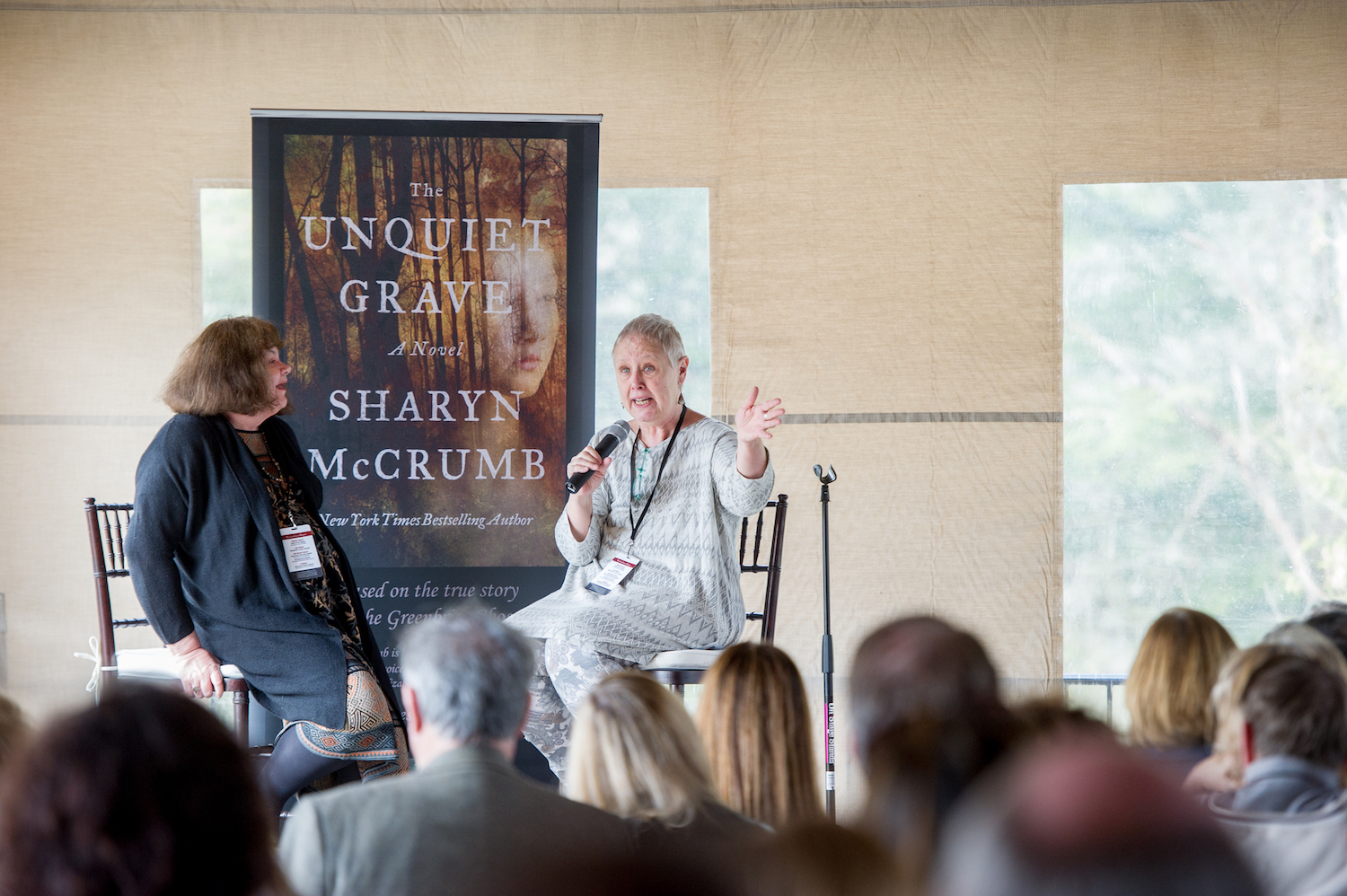 McCrumb
explained that the enduring tradition
of Appalachian people cherishing their own ghost
stories goes back to Scottish
immigrant folklore brought to the misty hills of
North Carolina with names like
“The Story of Boojum and Hootin’ Annie,” “The
Moon-Eyed People” and “The Demon
Dog of Valle Crucis.” Hiking the
extensive trails of the region is always finished
before twilight.
McCrumb
explained that the enduring tradition
of Appalachian people cherishing their own ghost
stories goes back to Scottish
immigrant folklore brought to the misty hills of
North Carolina with names like
“The Story of Boojum and Hootin’ Annie,” “The
Moon-Eyed People” and “The Demon
Dog of Valle Crucis.” Hiking the
extensive trails of the region is always finished
before twilight.
During
the festival I stayed at the Old Edwards
Inn and Spa, whose elegance depends on a décor
well adapted from Appalachian and
European traditions wed to all the modern
amenities. One of the most
comfortable and comforting places to loaf over
well-made cocktails is at the
Inn’s Hummingbird Lounge or in the beautifully
appointed library. One of the
Inn’s principal virtues is its bucolic quiet,
maintained by an enforced policy
for a “sleep-friendly environment” and
“zero-tolerance noise policy,” with
too-loud revelers booted off the property.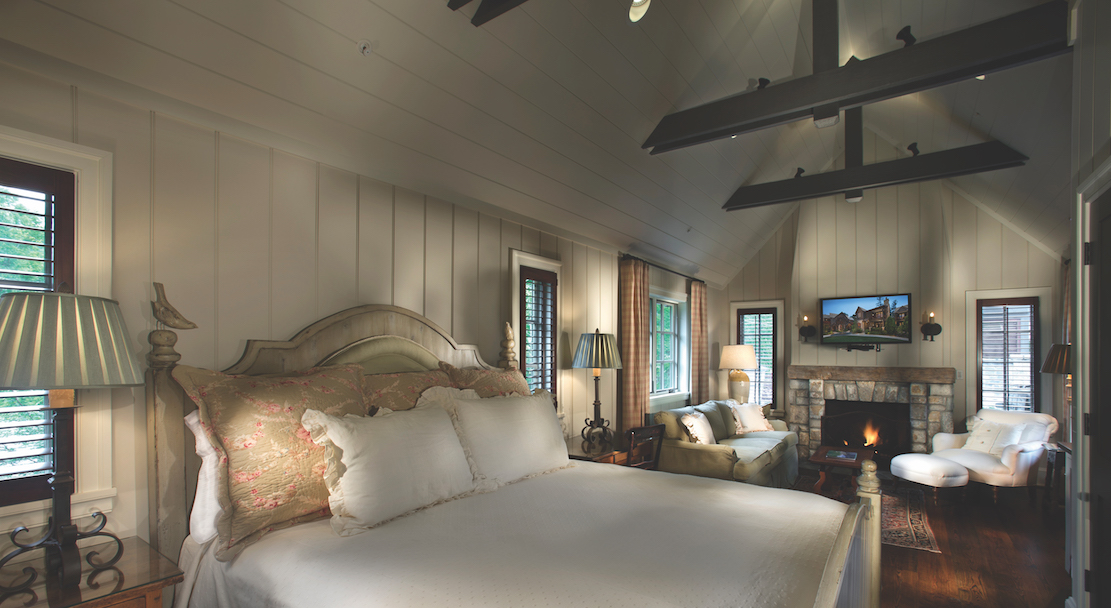
The Inn also has one of the
finest restaurants
in the South, Madison’s, with a menu that features
sustainable, local provender
from purveyors with regional names like Sunburst
Trout Farm, Painted Hills
Farm, Anson Mills, Benton's Country Ham and
Sequatchie Cove. Executive Chef
Chris Huerta uses them all to create the sumptuous
menu backed by a first-rate
wine list overseen by the ebullient sommelier
Philippe Brainos.
 At breakfast, as the sun
dissipated the morning
mist outside, I enjoyed hot buttermilk biscuits
with pan gravy and housemade
sausage. At
dinner, I stayed close
to the kitchen’s North Carolina roots with a
potato-and-ham hock soup with
bacon jam, cheddar, a fried egg yolk and green
onions ($9); very well-wrought
charcuterie; and what is possibly the best
rendering of sunburst trout I’ve
ever had in the South, with spaghetti squash and
andouille cream, roasted
beets, baby bok choy and almond-beet pesto ($27).
Lobster bisque is touched with American caviar
($9), and beer tartare is graced with balsamic
vinegar, an egg and grilled bread. Seared sea
scallops ($15) were superbly rendered, with creamy
cauliflower, and acorn squash, farro, dried
raisins and cashew jus ($16). Pheasant breast is
stuffed with mushrooms and accompanied by a lentil
ragôut, squash ratatouille and hen-of-the-woods
mushrooms ($28), and short ribs are braised slowly
for 48 hours and sided with root vegetable risotto
and cheddar ($30). Dishes can be too complicated,
confusing flavors, but largesse fills every plate,
not least in pastry chef Vinzenz
Aschbacher's desserts like English toffee
pudding. seven layer cake and the warm seasonal
fruit cobbler.
At breakfast, as the sun
dissipated the morning
mist outside, I enjoyed hot buttermilk biscuits
with pan gravy and housemade
sausage. At
dinner, I stayed close
to the kitchen’s North Carolina roots with a
potato-and-ham hock soup with
bacon jam, cheddar, a fried egg yolk and green
onions ($9); very well-wrought
charcuterie; and what is possibly the best
rendering of sunburst trout I’ve
ever had in the South, with spaghetti squash and
andouille cream, roasted
beets, baby bok choy and almond-beet pesto ($27).
Lobster bisque is touched with American caviar
($9), and beer tartare is graced with balsamic
vinegar, an egg and grilled bread. Seared sea
scallops ($15) were superbly rendered, with creamy
cauliflower, and acorn squash, farro, dried
raisins and cashew jus ($16). Pheasant breast is
stuffed with mushrooms and accompanied by a lentil
ragôut, squash ratatouille and hen-of-the-woods
mushrooms ($28), and short ribs are braised slowly
for 48 hours and sided with root vegetable risotto
and cheddar ($30). Dishes can be too complicated,
confusing flavors, but largesse fills every plate,
not least in pastry chef Vinzenz
Aschbacher's desserts like English toffee
pudding. seven layer cake and the warm seasonal
fruit cobbler.
The Inn also runs a sprawling
nearby property
called Half-Mile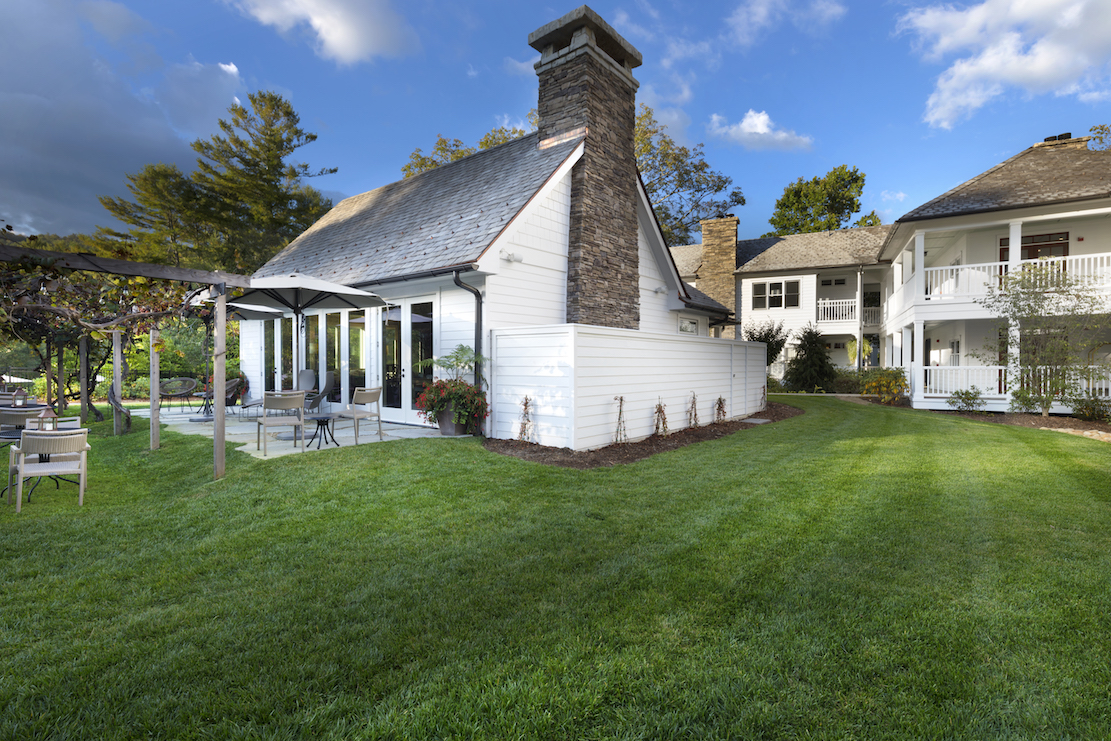 Farm (right)
overlooking Apple Lake, offering both contemporary
lodgings and several still rustic cabins set close
to the woods.
Farm (right)
overlooking Apple Lake, offering both contemporary
lodgings and several still rustic cabins set close
to the woods.
I can’t say that Highland gets
overrun with
second homers and tourists in summer, but spring
is breaking out just about
now, reminding me of the old folk song “Wildwood
Flower” as sung by the Carter
Family:
I will twine, I will
mingle my raven black hair
With the roses so red and the lilies so fair.
And the myrtle so bright with it's emerald hue
The pale amanita and the hyssop so blue.
❖❖❖
By John Mariani
Times Square
365 West 46th Street
212-262-8880

Whatever
you think of the overwhelming dazzle
of today’s Times Square and the Great White
Way, the restaurants in the area
have never been better, especially when it
comes to Asian food. In sheer
numbers it would be hard to pass by more than
half a dozen storefronts on any
street extending east and west from Times
Square and not find a sushi bar,
Chinese restaurant, Thai, Korean or Indian
eatery, at various price levels,
usually with pre-theater menus.
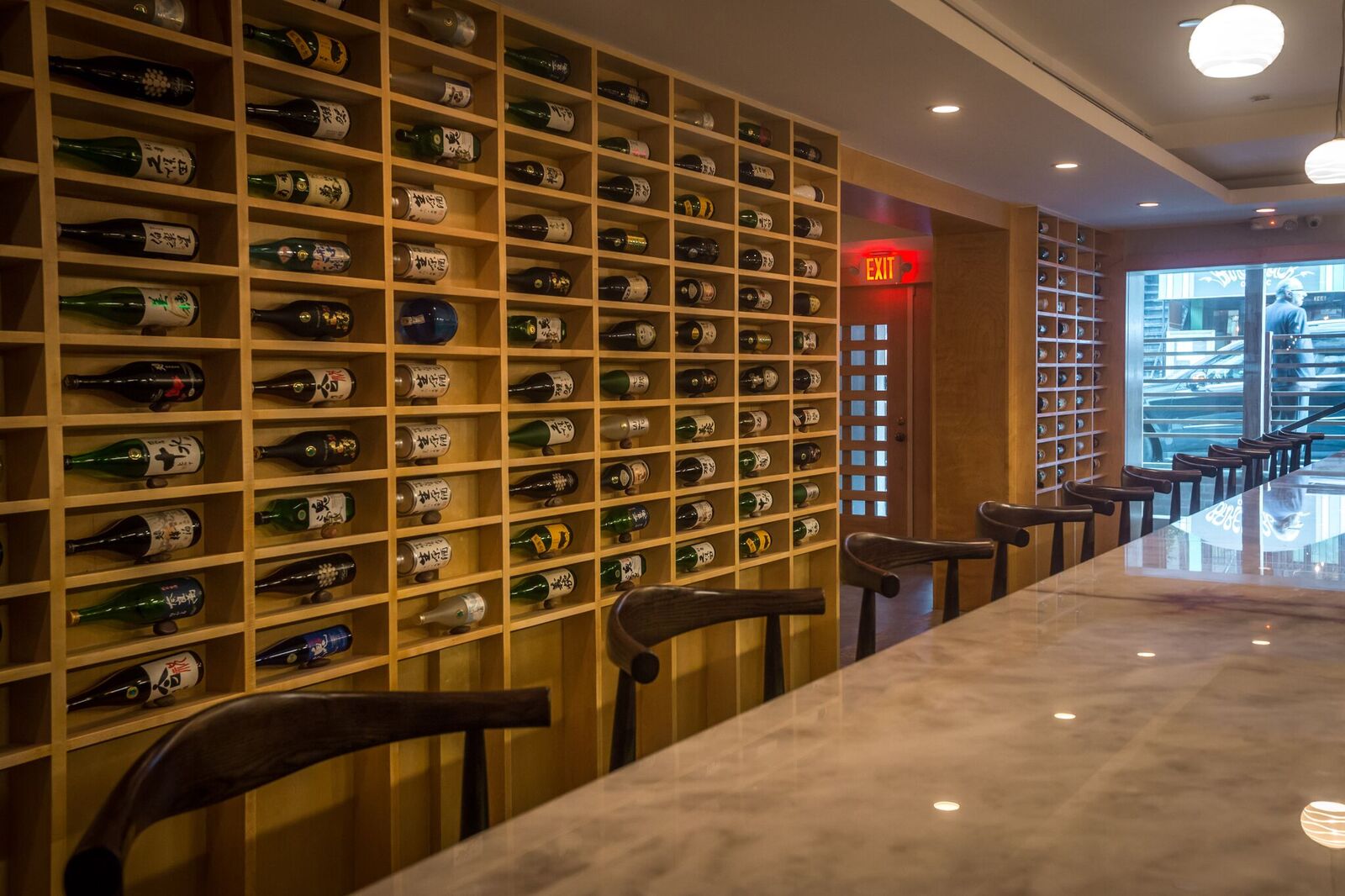 Sushi
Seki Times Square—named for Chef Seki
Shi—is the flagship of a group of three, with
branches on the East Side and
Chelsea, and it distinguishes itself by having a
sushi bar and lounge up front,
an omakase
sushi room upstairs where
Chef Seki works, and the six-seat Kappo Room to
the rear, featuring both à la
carte and a fixed price menu at a remarkably
fair $75, as well as a
sommelier of sake and wine.
Sushi
Seki Times Square—named for Chef Seki
Shi—is the flagship of a group of three, with
branches on the East Side and
Chelsea, and it distinguishes itself by having a
sushi bar and lounge up front,
an omakase
sushi room upstairs where
Chef Seki works, and the six-seat Kappo Room to
the rear, featuring both à la
carte and a fixed price menu at a remarkably
fair $75, as well as a
sommelier of sake and wine.
Chef Seki learned his craft
and developed his
knowledge of fish at Tokyo’s famed Tsukiji
Market, moving to New York in 1991
to work at a series of Japanese restaurants that
included Sushi of Gari, then
opening the first Sushi Seki on First Avenue
uptown. In 2014 the Chelsea branch
debuted, and this past year Times Square opened.
Yasuyuki Suzuki serves as
both general manager
and sake sommelier, having completed the Brewing
Society of Japanese Sake
Tasting Master Program to certify as an Advanced
Sake Professional. So the
array of sakes is superb, and “Yasu” happily
provides information about all of
them to match with your meal. What
Yasu does not provide, service and beverage
director Rick Zouad does with
wines, and I trust his judgment with pairings.. Both are very affable
fellows, as is the whole staff.
At the entrance there
is a “mini-omakase bar” sushi
counter (above),
where Chef
Qing Yang (who is
actually Chinese) shows a  deft
hand at seeming to do very little with
delectable results to top quality seafood. The
fat strips in the toro are
evident, the red snapper
glistens, and the rice is impeccably formed and
seasoned—no need for soy sauce
and wasabi dipping.
deft
hand at seeming to do very little with
delectable results to top quality seafood. The
fat strips in the toro are
evident, the red snapper
glistens, and the rice is impeccably formed and
seasoned—no need for soy sauce
and wasabi dipping.
My
problem with sushi is I can’t get enough of
it—which is why inferior sushi bars push “all
you can eat” menus. And after such delicacies
as Yang’s toro
taku (bluefin toro with pickled daikon tartare);
hamachi of yellowtail with a
sliver of jalapeño, garlic puree and ponzu; New
Zealand King salmon with onion
sauce and tomato sauté; tai shio
of
red snapper with lemon juice and Okinawa sea
salt; and “Tofu Tofu” of lean
bluefin tuna akami
on pan-seared tofu
topped with tofu sauce, I was both blissful and
ravenous for more.
But we were on our way to the
Kappo Room (right)—kappo
means to cook, and refers to a
dining spot somewhere
between the traditional kaiseki
cuisine and the casual izakaya
style cuisine. There we
sat at another counter in front of an open
kitchen—not a particularly
attractive or 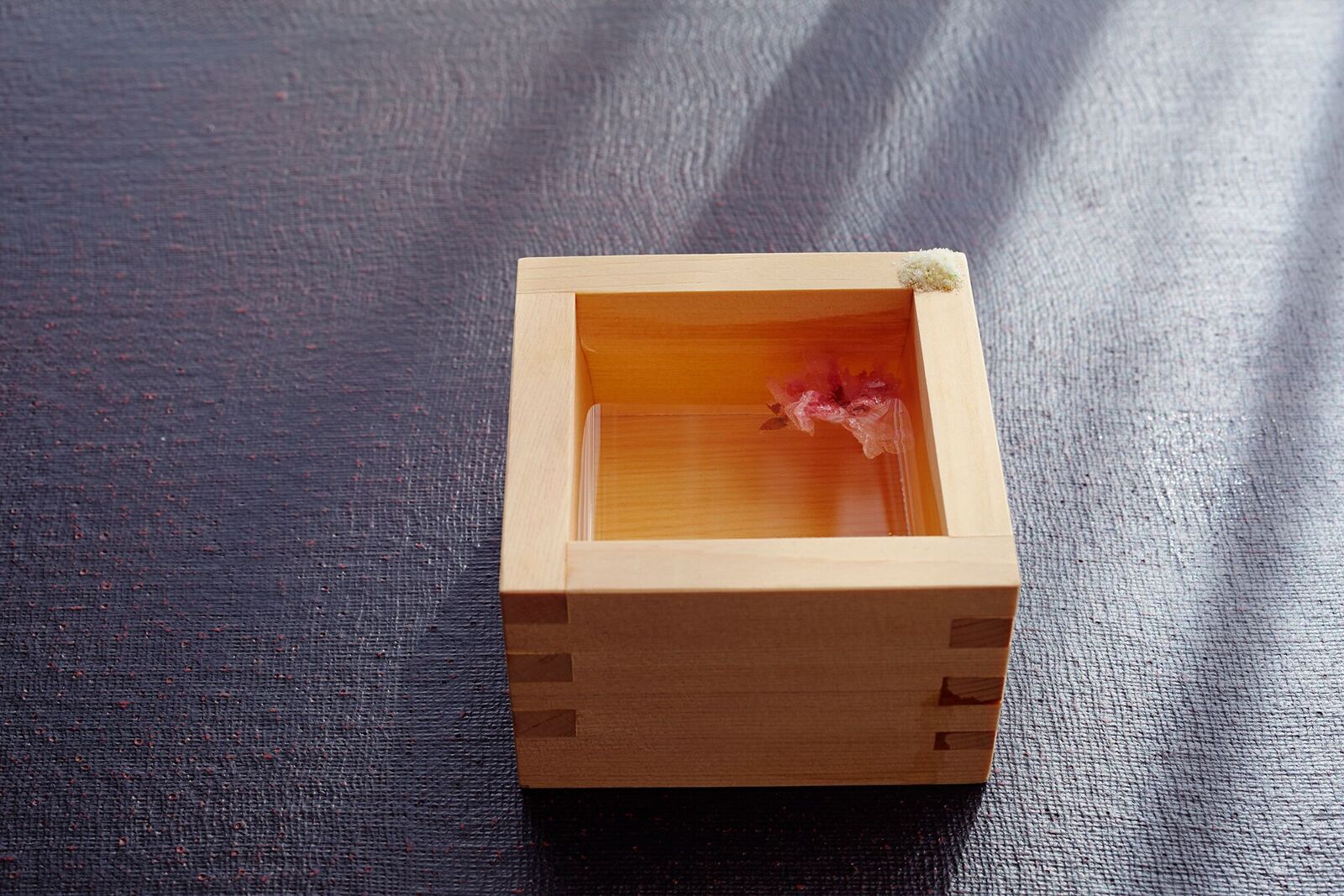 well-lighted one—to
feast further on an array of modern Japanese
seasonal cuisine, beginning with a fried Pacific
oyster with tomato tartare,
and slowly poached, velvety tender Hokkaido
octopus with simmered daikon and
pan-fried gyoza
of pork and cabbage,
accompanied by a 2014 Sauvignon Blanc from
Soliste “Lune et Soleil.”
well-lighted one—to
feast further on an array of modern Japanese
seasonal cuisine, beginning with a fried Pacific
oyster with tomato tartare,
and slowly poached, velvety tender Hokkaido
octopus with simmered daikon and
pan-fried gyoza
of pork and cabbage,
accompanied by a 2014 Sauvignon Blanc from
Soliste “Lune et Soleil.”
Next was a crisp tempura dish
of anago
(sea eel), kuruma ebi (black tiger shrimp), wakasagi (lake smelt) and assorted
vegetables, with a Domaine
Ferret “Le Clos” 2013.
Lustrous yuzu and
miso-infused cod had its
characteristic richness, which paired well with
a Guy Breton Morgon Régnié
2015, then came a soothing hot pot of duck and
tofu in sweet dashi
broth with which a Choryo
“Tarusake” Junmai Yamahai sake from Nara went
beautifully.
All of this food lay lightly
on the stomach, so
we were happy to try several desserts that were
way out of the ordinary for a
Japanese restaurant: creamy yuzu panna
cotta; a honeyed crème brûlée; and mochi
ice cream of matcha,
salted caramel,
Mandarin orange cream and double chocolate. All
were part of the $75 menu,
though all items are also available à la carte.
I’m
sure I’d be just as happy upstairs eating
nothing but classic sushi made by Chef Seki, but
I’d be missing so much more
from the downstairs menus. What a happy dilemma
to have!
Open nightly for dinner.
❖❖❖
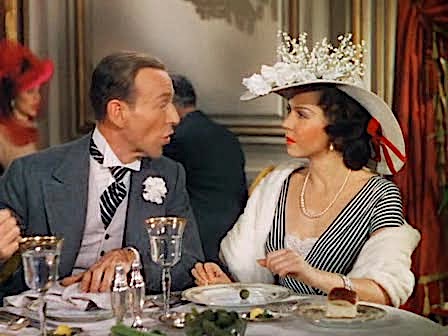
WINES FOR
EASTER DINNER
By John Mariani
Fred Astaire and Ann Miller in "Easter Parade" (1948)
Thanksgiving
is so identified with a lavish turkey dinner
that the
Easter meal seems to divert deliberately
from such a menu. Depending on one’s
own family origins, lamb or ham are
traditional Easter dishes, so choosing
wines for the feast brings a different set
of criteria.
For one thing, the
meal is usually held in the middle
of the day, which suggests lighter wines might
be considered. At Russian
Orthodox Easter, the meal is traditionally
held after midnight Mass and involves
only cold foods and plenty of vodka shots, not
much wine.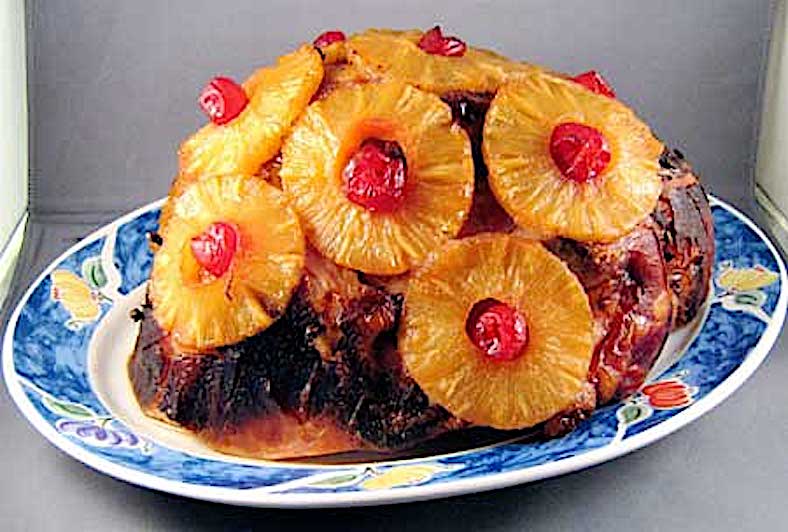
After 40 days of Lent, seafood is
banned from the Easter table, and
although colored eggs may decorate the table,
they are rarely consumed, unless
among the ingredients for a cheesecake at the
end.
Baked ham, usually
spiked with spices like cloves
stuck into a brown sugar glazed skin and often
topped with caramelized
pineapple slices, is not the easiest dish to
pair up with wines. Among white wines a
French Burgundy can
be too subtle, while a California Chardonnay
may be too oaky. Craggy
Range’s
Single Vineyard 2015 Chardonnay ($21) from New
Zealand is neither, with very
pleasing fruit and citrus at a very good
price.
Craggy
Range’s
Single Vineyard 2015 Chardonnay ($21) from New
Zealand is neither, with very
pleasing fruit and citrus at a very good
price.
I prefer the
slight hint of grassy sweetness in a
Sauvignon Blanc, either a Loire Valley
Sancerre or perhaps Sonoma Valley’s
Château St. Jean Fumé Blanc 2015 ($12), which
has a definite pineapple note to
it.
Best of all with
such hams would be a Gewürztraminer, a wine
defined by
its spiciness and aromatics, and my first
choice would be an Alsatian example
from a fine producer like Trimbach ($25) or
Hugel (18). Washington’s Hogue
Cellars’s 2015 ($9) from Washington State has
a slightly gingery component.
And then there is
Lambrusco, the sparkling red wine
from Emilia-Romagna; too often too sweet, the
drier versions are excellent
choices for spiced ham. Look
for Otello Nero di Lambrusco ($22). Aged
Beaujolais, like Domaine des
Quatres Vents 2015 Fleurie ($22), have just
the right acid to cut through sweet
ham. 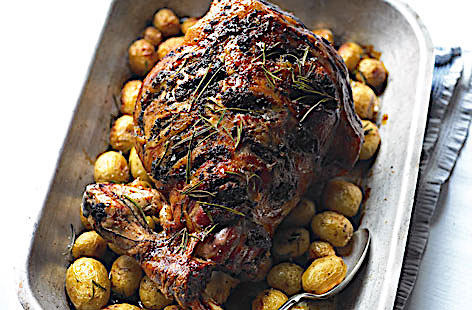
But my favorite
red wine with baked ham is Italy’s
Amarone della Valpolicella, made in the Veneto
by drying Valpolicella grapes on
straw mats to intensify their flavors and
sugar. It is vinified dry but
always retains a luscious
underpinning of sweetness, more like an
off-dry port than a tannic red
wine. That
undercurrent of
sweetness is a complement to the seasonings
and salt of the ham. The producers
I like on a regular basis include Bertani,
Zenato and Bolla.
 If
lamb is being served at Easter, perhaps served
with
a mint sauce, a good choice because of its own
spice and a bright raspberry
fruitiness is the Pinot Noir from Cuvaison
2015 ($52). Well-fatted baby lamb
begs for a refined red like a Piedmontese
Nebbiolo grape, which goes into the
making of that region’s great Barolos by
Rocche dei Manzoni 2011 ($50) or
Fontanafredda 2013 ($40), which is a fine,
robust traditional style.
If
lamb is being served at Easter, perhaps served
with
a mint sauce, a good choice because of its own
spice and a bright raspberry
fruitiness is the Pinot Noir from Cuvaison
2015 ($52). Well-fatted baby lamb
begs for a refined red like a Piedmontese
Nebbiolo grape, which goes into the
making of that region’s great Barolos by
Rocche dei Manzoni 2011 ($50) or
Fontanafredda 2013 ($40), which is a fine,
robust traditional style.
If a big Cabernet
Sauvignon is your wont, Clos
Pegase’s 2012 Hommage ($152) will be
impressive to your guests. Considerably
fruitier is a Cab from
Australia’s Barossa Valley Estate 2016 ($15).
Spicier still is Jacob’s Creek
Double Barrel Shiraz aged in whiskey oak
barrels ($19). More austere but a good match
for the richness of lamb
is a Bordeaux by Légende 2016 ($12).
❖❖❖
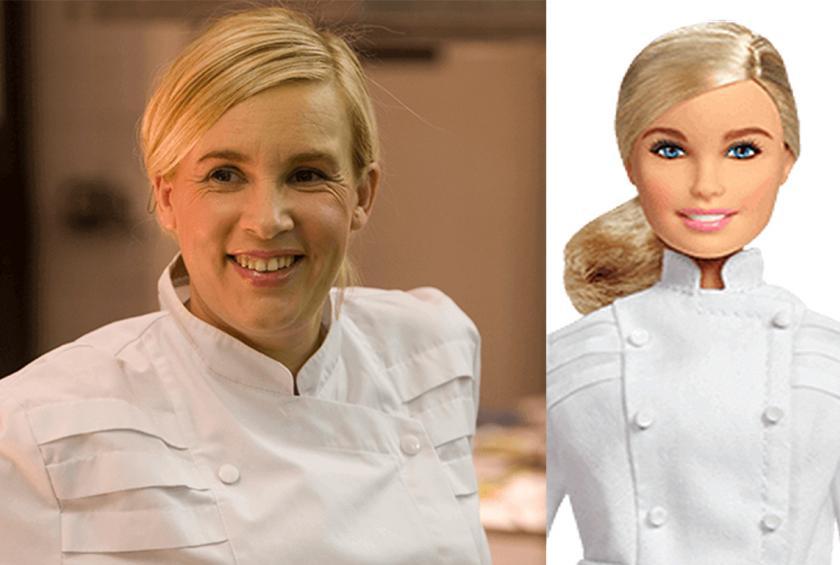
NOSE, THE MOUTH AND THE AGE,
IT LOOKS JUST LIKE HER!
Toymaker Mattel has released 19 new
Barbies to
celebrate present day and historic female role models.
including French chef Hélène Darroze, 51, who has
restaurants in The Connaught in London and
her namesake Hélène Darroze in Paris and Moscow.
FOOD WRITING 101: BLOCK THOSE PARADIGMS!
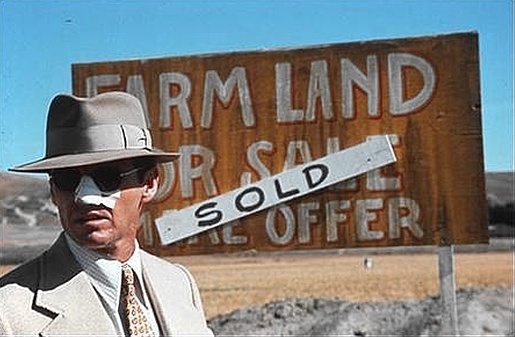
“The frenzy around Vespertine eclipsed the arrival of
Dialogue, which is the restaurant I’d much more readily
recommend. As in opera or art or theater, enjoyment at
this altitude becomes a matter of preference. To couch
it in cinematic terms, Vespertine puts me in the mind of
Luis Buñuel’s surrealist The Exterminating Angel.
I gravitate toward Beran’s menu. It certainly doesn’t
shy away from surrealism, but its setup is as satisfying
as Robert Towne’s screenplay for Chinatown — a paradigm of the three-act
form.”—Bill Addison, “Dialogue,” Eater.com
(12/26/17)
Wine
Column Sponsored by Banfi Vintners
SANGIOVESE
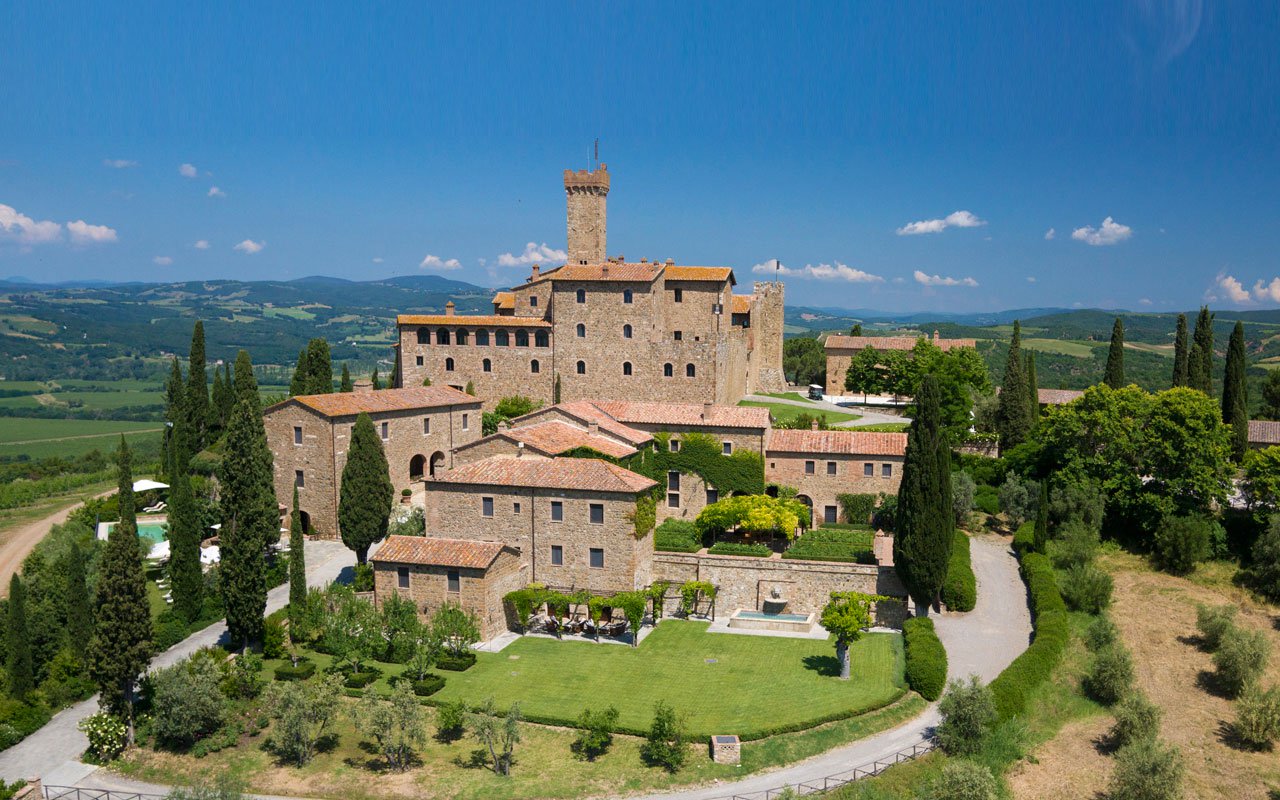 Wine is a joy year-round but in cooler
weather one grape
varietal has really taken center stage in my daily
activities – that most Italian of grapes,
Sangiovese, and its ultimate expression – Brunello
di Montalcino.
Wine is a joy year-round but in cooler
weather one grape
varietal has really taken center stage in my daily
activities – that most Italian of grapes,
Sangiovese, and its ultimate expression – Brunello
di Montalcino.
From
mid-September through mid-October, the Sangiovese
grown for our various styles of red wines are be
harvested, culminating with the top selection for
Brunello di Montalcino.
Second, cooler weather here means
it is time to start enjoying more red wines and
especially Sangiovese based wines. That
includes Banfi’s cru of Brunello, Poggio alle Mura,
literally the cream of the crop of our Sangiovese
vineyards. Alongside our Poggio alle Mura Brunello di
Montalcino, this year we introduced two more wines
from the cru Poggio alle Mura – a Rosso di Montalcino
and a Riserva of Brunello. Rosso is sort of like the
younger brother of Brunello, also made from 100%
Sangiovese grapes but usually a selection from younger
vines and the wine is aged only two years compared to
the four required for Brunello. The
Riserva, on the other hand, is an even more selective
harvest of Sangiovese, and ages for an additional year
before release.
What is so
special about this cru Poggio alle Mura? Well, it is
the result our over 30 years of ongoing research at my
family’s vineyard estate, Castello Banfi. When we
first began planting our vines there in the late 1970s
studies from the University of Bordeaux indicated
which strains of many varietals we should plant, based
on the soil type and microclimate of each vineyard. But when it
came to the region’s native Sangiovese, there was only
local lore, no scientific research. So we took
it upon ourselves to figure out this vine, and set off
on three decades of incredibly detailed research.
We
started with 600 apparent variations on Sangiovese,
because it is so susceptible to variations in weather
and soil, and narrowed that down to 160 truly
genetically different clones. We planted
a vineyard with two rows of each type, made wine from
each of them, and charted the differences – remember,
you only get one chance a year to make wine, so this
took time.
It took about ten years to get some
concrete results, though we continue to experiment
today and always will – you never stop learning in
science and nature!
Once we determined which were the best,
complementary clones that could be planted together to
make the best Brunello, we chose to plant them in what
we determined to be the optimal vineyard sites. Coincidentally,
the best soils and climate conditions are in the
slopes surrounding the medieval fortress today known
as Castello Banfi, known since Etruscan times as
Poggio alle Mura – the walled hilltop. Hence the
name of our most special “cru” of Brunello,
representing a synthesis between tradition and
innovation.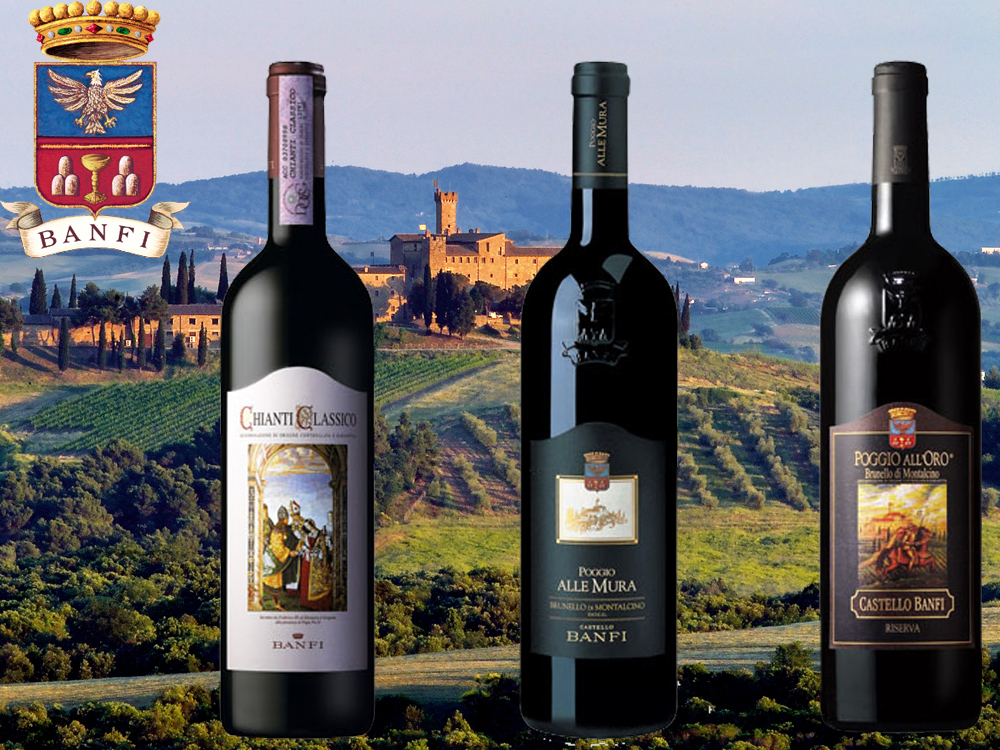
Though the
focus of this study was our Brunello, all of our
Sangiovese-based wines, including the super Tuscans
SummuS, Cum Laude, and Centine, benefited from this
work. And
that’s the third reason for celebrating Sangiovese
this month, for the range of wonderful reds that usher
us into autumn!
One wine in particular was inspired by our
research – the BelnerO, a Sangiovese dominant blend
with what I like to call a kiss of Cabernet and a
whisper of Merlot.
We grow the grapes a little differently for
BelnerO than for Brunello, make the wine with less oak
aging and released it earlier from the winery,
providing a counterpoint to Brunello and a lovely
terroir-driven wine in its own right.
If you know Italians, you know that by nature
we are multi-faceted, varying in mood, and always
passionate. As
a nation, we span from the hot sunny beaches of Sicily
near the African coast to the rugged mountains and
Alpine ski slopes of Trentino-Alto Adige in the north. Sangiovese
is grown in almost all of Italy’s regions and reflects
the unique nature of each; it is most famous
(rightfully so) in Tuscany, yet even there it reflects
the nuances of each hilltop, valley and subzone. It has
something a little different to say in Brunello than
Chianti, Morellino than Vino Nobile di Montepulciano,
Rosso di Montalcino than Super Tuscan blends.
Here is a smattering
of Sangiovese-based wines that you may wish to get to
know better, reflecting a spectrum that appeals to
every occasion, every taste, and every budget. We can
assure you that the conversation will never become
boring.
Recommendations for Celebrating
Sangiovese
BelnerO Proprietor’s Reserve Sangiovese
– A refined
cuvée of noble red grapes perfected by our pioneering
clonal research. This dark beauty, BelnerO, is
produced at our innovative winery, chosen 11
consecutive years as Italy’s Premier Vineyard Estate.
Fermented in our patented temperature controlled
French oak and aged approximately 2 additional years.
Unfiltered, and Nitrogen bottled to minimize sulfites.
Castello Banfi Brunello di Montalcino –
Rich, round, velvety and intensely
aromatic, with flavor hints of licorice, cherry, and
spices. Brunello di Montalcino possesses an intense
ruby-red color, and a depth, complexity and opulence
that is softened by an elegant, lingering aftertaste.
Unfiltered after 1998 vintage.
Castello Banfi Rosso di Montalcino – Brunello's "younger brother," produced
from select Sangiovese grapes and aged in barrique for
10 to 12 months. Deep ruby-red, elegant, vibrant,
well-balanced and stylish with a dry velvety
finish.
Poggio all’Oro Brunello di Montalcino
Riserva – A single vineyard selection of our most
historically outstanding Sangiovese, aged five years
before release, the additional year more than that
required of Brunello including 6 months in barrel and
6 months more in bottle to grant its “Riserva”
designation. Incredible
elegance and harmony. Intense with lots of fruit and
subtle wood influence. Round, complete, well balanced
with hints of chocolate and berries. Unfiltered after
1998.
Poggio alle Mura – The first tangible result of years of
intensive clonal research on Montalcino’s native
Sangiovese grape.
Estate bottled from the splendidly sun drenched
vineyards surrounding the medieval Castello from which
it takes its name.
The Brunello
di Montalcino is seductive, silky and smoky. Deep ruby
in color with an expressive bouquet of violets, fruits
and berries as well as cigar box, cedar and exotic
spices. The Rosso
di Montalcino is also intense ruby red. The bouquet
is fresh and fruity with typical varietal notes of
cherry and blackberry, enriched by more complex hints
of licorice, tobacco and hazelnut. It is full
bodied, yet with a soft structure, and a surprisingly
long finish. The Poggio alle Mura Brunello di Montalcino
Riserva is deep ruby red with garnet
reflections and a rich, ample bouquet that hints of
prune jam, coffee, cacao and a light balsamic note. It is full
and powerful, with ripe and gentle tannins that make
it velvety and harmonious; this wine is supported by a
pleasing minerality that to me speaks soundly of that
special hillsidein southern Montalcino.
SummuS – A wine of towering elegance, SummuS is an
extraordinary blend of Sangiovese which contributes
body; Cabernet Sauvignon for fruit and structure; and
Syrah for elegance, character and a fruity bouquet. An elegant,
complex and harmonious red wine.
Cum Laude – A complex and elegant red which graduated
“With Honors,” characterized by aromas of juicy
berries and fresh spices.
Centine – A Cuvee that is more than half
Sangiovese, the balanced consisting of equal parts of
Cabernet Sauvignon and Merlot. Vinified in
a firm, round style that easily accompanies a wide
range of dishes, this is a smooth and fragrantly
satisfying wine with international character, and a
perennial favorite at my own dinner table.
Banfi Chianti Superiore – The “Superiore” designation signifies
stricter government regulations regarding production
and aging requirements, as compared to regular
Chianti. An
intense ruby red wine with fruit forward aromas and
floral notes. This
is a round wine with well-balanced acidity and fruit.
Banfi Chianti Classico – An enduring classic: alluring
bouquet of black fruit and violets; rich flavors of
cherry and leather; supple tannins and good acidity
for dining.
Banfi Chianti Classico Riserva – Produced from select grapes grown in the
"Classico" region of Chianti, this dry, fruity and
well-balanced red has a full bouquet reminiscent of
violets.
Fonte alla Selva Chianti Classico – This is our newest entry into the Chianti
arena, coming from a 99 acre estate in Castellina, the
heart of the Chianti Classico region. The wine is
a captivating mauve red that smells of cherry, plum
and blackberry with hints of spice. It is
round, full and balanced with very good
acidity.
Col di Sasso – Sangiovese and Cabernet Sauvignon. Luscious,
complex and soft with persistent notes of fruit and
great Italian style structure.
Any of John Mariani's books below may be ordered from amazon.com.
 The Hound in Heaven
(21st Century Lion Books) is a novella, and
for anyone who loves dogs, Christmas, romance,
inspiration, even the supernatural, I hope you'll find
this to be a treasured favorite. The story
concerns how, after a New England teacher, his wife and
their two daughters adopt a stray puppy found in their
barn in northern Maine, their lives seem full of promise.
But when tragedy strikes, their wonderful dog Lazarus and
the spirit of Christmas are the only things that may bring
his master back from the edge of despair.
The Hound in Heaven
(21st Century Lion Books) is a novella, and
for anyone who loves dogs, Christmas, romance,
inspiration, even the supernatural, I hope you'll find
this to be a treasured favorite. The story
concerns how, after a New England teacher, his wife and
their two daughters adopt a stray puppy found in their
barn in northern Maine, their lives seem full of promise.
But when tragedy strikes, their wonderful dog Lazarus and
the spirit of Christmas are the only things that may bring
his master back from the edge of despair. WATCH THE VIDEO!
“What a huge surprise turn this story took! I was completely stunned! I truly enjoyed this book and its message.” – Actress Ali MacGraw
“He had me at Page One. The amount of heart, human insight, soul searching, and deft literary strength that John Mariani pours into this airtight novella is vertigo-inducing. Perhaps ‘wow’ would be the best comment.” – James Dalessandro, author of Bohemian Heart and 1906.
“John Mariani’s Hound in Heaven starts with a well-painted portrayal of an American family, along with the requisite dog. A surprise event flips the action of the novel and captures us for a voyage leading to a hopeful and heart-warming message. A page turning, one sitting read, it’s the perfect antidote for the winter and promotion of holiday celebration.” – Ann Pearlman, author of The Christmas Cookie Club and A Gift for my Sister.
“John Mariani’s concise, achingly beautiful novella pulls a literary rabbit out of a hat – a mash-up of the cosmic and the intimate, the tragic and the heart-warming – a Christmas tale for all ages, and all faiths. Read it to your children, read it to yourself… but read it. Early and often. Highly recommended.” – Jay Bonansinga, New York Times bestselling author of Pinkerton’s War, The Sinking of The Eastland, and The Walking Dead: The Road To Woodbury.
“Amazing things happen when you open your heart to an animal. The Hound in Heaven delivers a powerful story of healing that is forged in the spiritual relationship between a man and his best friend. The book brings a message of hope that can enrich our images of family, love, and loss.” – Dr. Barbara Royal, author of The Royal Treatment.
 |
The Encyclopedia of American Food and Drink by John F. Mariani (Bloomsbury USA, $35) Modesty forbids me to praise my own new book, but let me proudly say that it is an extensive revision of the 4th edition that appeared more than a decade ago, before locavores, molecular cuisine, modernist cuisine, the Food Network and so much more, now included. Word origins have been completely updated, as have per capita consumption and production stats. Most important, for the first time since publication in the 1980s, the book includes more than 100 biographies of Americans who have changed the way we cook, eat and drink -- from Fannie Farmer and Julia Child to Robert Mondavi and Thomas Keller. "This book is amazing! It has entries for everything from `abalone' to `zwieback,' plus more than 500 recipes for classic American dishes and drinks."--Devra First, The Boston Globe. "Much needed in any kitchen library."--Bon Appetit. |
"Eating Italian will never be the same after reading John Mariani's entertaining and savory gastronomical history of the cuisine of Italy and how it won over appetites worldwide. . . . This book is such a tasteful narrative that it will literally make you hungry for Italian food and arouse your appetite for gastronomical history."--Don Oldenburg, USA Today. "Italian
restaurants--some good, some glitzy--far
outnumber their French rivals. Many of
these establishments are zestfully described
in How Italian Food Conquered the World, an
entertaining and fact-filled chronicle by
food-and-wine correspondent John F.
Mariani."--Aram Bakshian Jr., Wall Street
Journal.
"Equal parts
history, sociology, gastronomy, and just
plain fun, How Italian Food Conquered the
World tells the captivating and delicious
story of the (let's face it) everybody's
favorite cuisine with clarity, verve and
more than one surprise."--Colman Andrews,
editorial director of The Daily
Meal.com. "A fantastic and fascinating
read, covering everything from the influence
of Venice's spice trade to the impact of
Italian immigrants in America and the
evolution of alta cucina. This book will
serve as a terrific resource to anyone
interested in the real story of Italian
food."--Mary Ann Esposito, host of PBS-TV's
Ciao
Italia. "John Mariani has written the
definitive history of how Italians won their
way into our hearts, minds, and
stomachs. It's a story of pleasure over
pomp and taste over technique."--Danny Meyer,
owner of NYC restaurants Union Square
Cafe, The Modern, and Maialino.
|
 |
 |
 |
 |
 |
 |
 |
 |
 Everett Potter's Travel Report:
Everett Potter's Travel Report: 
 Eating Las Vegas
JOHN CURTAS has been covering the Las Vegas
food and restaurant scene since 1995. He is
the co-author of EATING LAS VEGAS – The 50
Essential Restaurants (as well as
the author of the Eating Las Vegas web site: www.eatinglasvegas.
He can also be seen every Friday morning as
the “resident foodie” for Wake Up With the
Wagners on KSNV TV (NBC) Channel 3 in
Las Vegas.
Eating Las Vegas
JOHN CURTAS has been covering the Las Vegas
food and restaurant scene since 1995. He is
the co-author of EATING LAS VEGAS – The 50
Essential Restaurants (as well as
the author of the Eating Las Vegas web site: www.eatinglasvegas.
He can also be seen every Friday morning as
the “resident foodie” for Wake Up With the
Wagners on KSNV TV (NBC) Channel 3 in
Las Vegas.

MARIANI'S VIRTUAL GOURMET
NEWSLETTER is published weekly. Editor/Publisher: John
Mariani.
Editor: Walter Bagley. Contributing Writers: Christopher Mariani,
Robert Mariani, Misha Mariani, John A. Curtas, Geoff Kalish, Mort
Hochstein, and
Brian Freedman. Contributing Photographer: Galina
Dargery. Technical Advisor: Gerry McLoughlin.
If you wish to subscribe to this
newsletter, please click here: http://www.johnmariani.com/subscribe/index.html
© copyright John Mariani 2017

